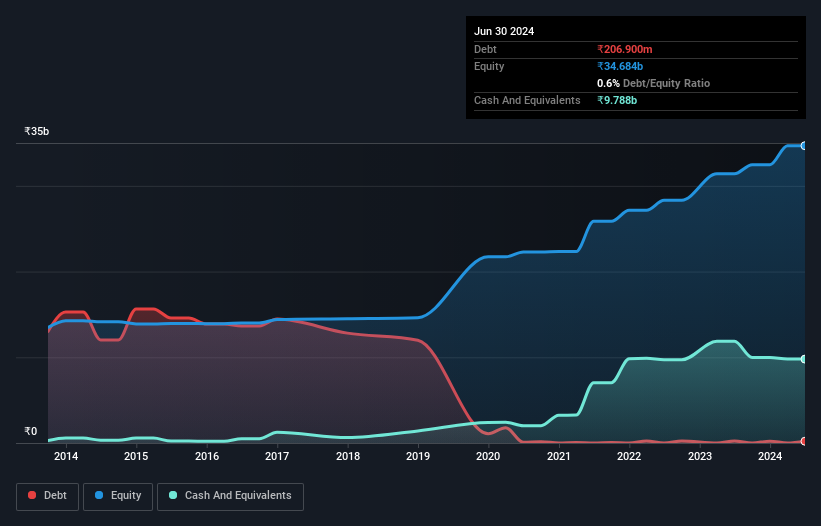Legendary fund manager Li Lu (who Charlie Munger backed) once said, 'The biggest investment risk is not the volatility of prices, but whether you will suffer a permanent loss of capital.' So it seems the smart money knows that debt - which is usually involved in bankruptcies - is a very important factor, when you assess how risky a company is. We note that Linde India Limited (NSE:LINDEINDIA) does have debt on its balance sheet. But is this debt a concern to shareholders?
When Is Debt A Problem?
Debt is a tool to help businesses grow, but if a business is incapable of paying off its lenders, then it exists at their mercy. Ultimately, if the company can't fulfill its legal obligations to repay debt, shareholders could walk away with nothing. However, a more common (but still painful) scenario is that it has to raise new equity capital at a low price, thus permanently diluting shareholders. Of course, the upside of debt is that it often represents cheap capital, especially when it replaces dilution in a company with the ability to reinvest at high rates of return. When we think about a company's use of debt, we first look at cash and debt together.
Check out our latest analysis for Linde India
What Is Linde India's Net Debt?
You can click the graphic below for the historical numbers, but it shows that Linde India had ₹206.9m of debt in March 2024, down from ₹220.5m, one year before. However, it does have ₹9.79b in cash offsetting this, leading to net cash of ₹9.58b.

How Strong Is Linde India's Balance Sheet?
We can see from the most recent balance sheet that Linde India had liabilities of ₹10.3b falling due within a year, and liabilities of ₹3.05b due beyond that. Offsetting this, it had ₹9.79b in cash and ₹7.44b in receivables that were due within 12 months. So it actually has ₹3.86b more liquid assets than total liabilities.
Having regard to Linde India's size, it seems that its liquid assets are well balanced with its total liabilities. So it's very unlikely that the ₹629.7b company is short on cash, but still worth keeping an eye on the balance sheet. Simply put, the fact that Linde India has more cash than debt is arguably a good indication that it can manage its debt safely.
And we also note warmly that Linde India grew its EBIT by 15% last year, making its debt load easier to handle. When analysing debt levels, the balance sheet is the obvious place to start. But ultimately the future profitability of the business will decide if Linde India can strengthen its balance sheet over time. So if you want to see what the professionals think, you might find this free report on analyst profit forecasts to be interesting.
Finally, a company can only pay off debt with cold hard cash, not accounting profits. While Linde India has net cash on its balance sheet, it's still worth taking a look at its ability to convert earnings before interest and tax (EBIT) to free cash flow, to help us understand how quickly it is building (or eroding) that cash balance. In the last three years, Linde India's free cash flow amounted to 24% of its EBIT, less than we'd expect. That weak cash conversion makes it more difficult to handle indebtedness.
Summing Up
While it is always sensible to investigate a company's debt, in this case Linde India has ₹9.58b in net cash and a decent-looking balance sheet. On top of that, it increased its EBIT by 15% in the last twelve months. So we don't have any problem with Linde India's use of debt. Above most other metrics, we think its important to track how fast earnings per share is growing, if at all. If you've also come to that realization, you're in luck, because today you can view this interactive graph of Linde India's earnings per share history for free.
Of course, if you're the type of investor who prefers buying stocks without the burden of debt, then don't hesitate to discover our exclusive list of net cash growth stocks, today.
New: AI Stock Screener & Alerts
Our new AI Stock Screener scans the market every day to uncover opportunities.
• Dividend Powerhouses (3%+ Yield)
• Undervalued Small Caps with Insider Buying
• High growth Tech and AI Companies
Or build your own from over 50 metrics.
Have feedback on this article? Concerned about the content? Get in touch with us directly. Alternatively, email editorial-team (at) simplywallst.com.
This article by Simply Wall St is general in nature. We provide commentary based on historical data and analyst forecasts only using an unbiased methodology and our articles are not intended to be financial advice. It does not constitute a recommendation to buy or sell any stock, and does not take account of your objectives, or your financial situation. We aim to bring you long-term focused analysis driven by fundamental data. Note that our analysis may not factor in the latest price-sensitive company announcements or qualitative material. Simply Wall St has no position in any stocks mentioned.
About NSEI:LINDEINDIA
Linde India
Manufactures and sells industrial and medical gases in India.
High growth potential with excellent balance sheet.
Similar Companies
Market Insights
Community Narratives




